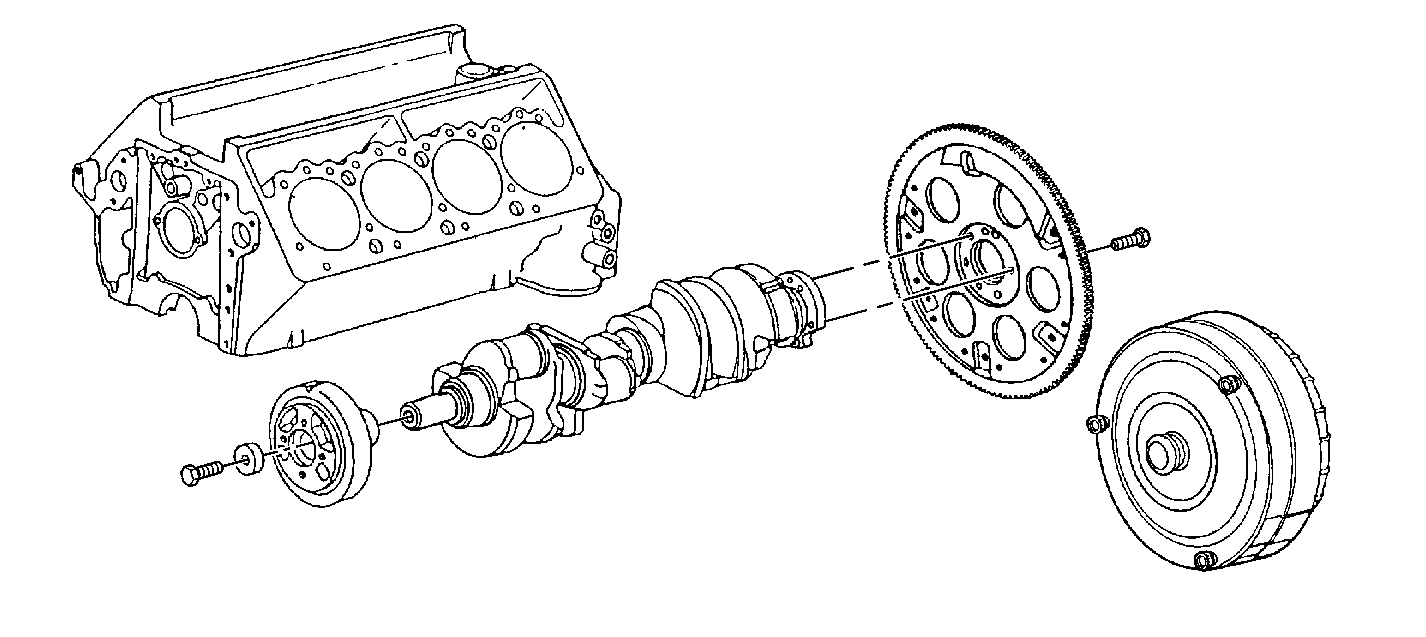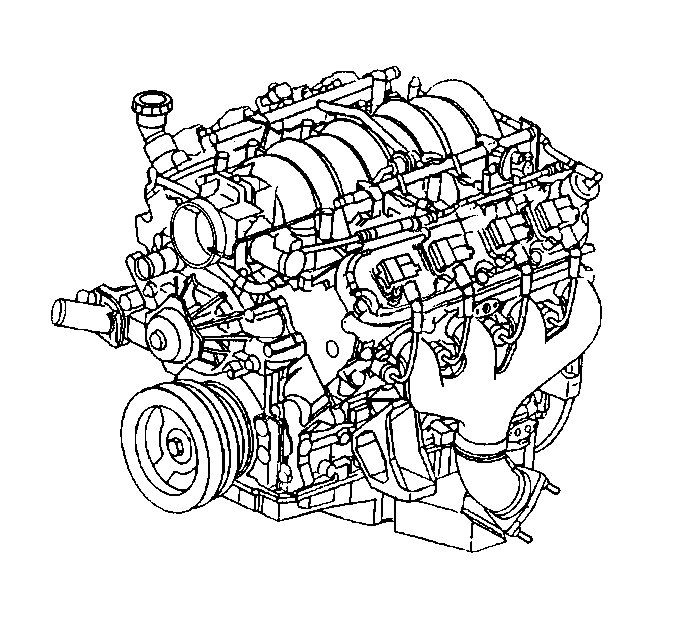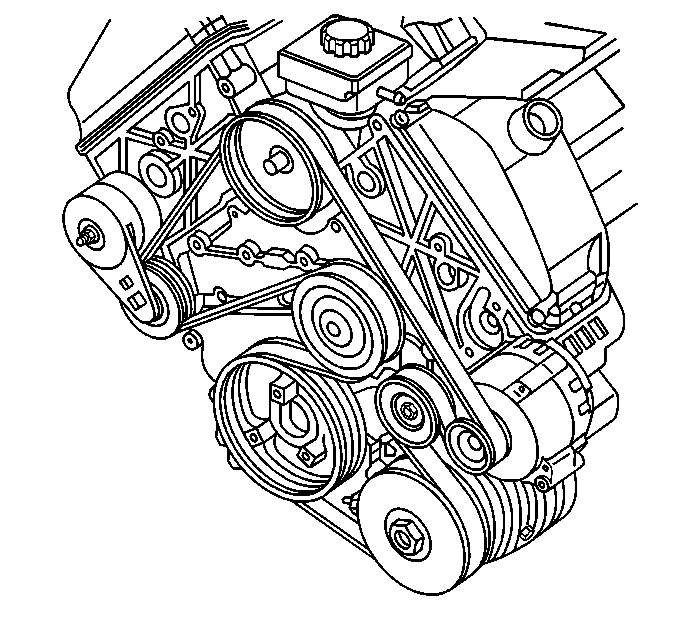Engine vibration is usually due to one or more of the following
conditions:
| • | First-order engine imbalance |
| • | Inherent engine firing sequence |
| • | Inherent shaking engine forces |
| • | Engine-driven accessories |
Because these vibrations are engine-speed related, they are also normally
torque sensitive. These vibrations may appear and disappear at different vehicle
or road speeds, but will always appear at the same engine speed.
For example, if a customer states that a vibration is present at 40 km/h
(25 mph), 64 km/h (40 mph), and again at 104 km/h
(65 mph), and that the symptoms of the vibration are similar
at all of these speeds, the vibration is probably engine-speed related.
Any disturbance or vibration that is present during the following
road tests would be considered engine-speed related:
| • | The Neutral run-up test |
Any vibration that is present during the Neutral coast-down test is
not engine-speed related. The engine-related vibrations covered in this diagnosis
are engine-speed sensitive only.
First-Order Engine Imbalance

Engine imbalance is a
condition that exists when a component that rotates at crankshaft speed is
either unbalanced or has excessive runout. In rare cases, the crankshaft
may be unbalanced. Balancing the component or correcting the runout
may bring the disturbance to an acceptable level.
Symptoms
| • | Vehicle shake at low speeds of 500-1,200 rpm, or
8-20 Hz |
| • | Roughness and BOOM at higher speeds of 1,200-3,000 rpm,
or 20-50 Hz |
| • | Vibration usually detected during the Neutral run-up test |
Isolating the Components
- Perform the Neutral run-up test, noting the RPM at which the vibration
is the worst, and the most severe. Refer to
Types of Road Test
.
- Inspect all powertrain mounts. Repair or replace as needed.
- Inspect for any bindings or ground-outs in the exhaust system.
- For automatic transmissions do the following:
| 4.1. | Mark the location of the torque converter to the flywheel. |
| 4.2. | Disconnect the torque converter from the flywheel and push the
converter back from the flywheel. |
| 4.3. | Tie up the converter, away from the flywheel. |
| 4.4. | Perform the Neutral run-up test again. Refer to
Types of Road Test
. Observe the flywheel. |
| 4.4.1. | Visually inspect from the side for any wobble or lateral runout. |
| 4.4.2. | If any wobble or lateral runout exists, replace the flywheel. |
| 4.5. | If the vibration is eliminated by disconnecting the torque converter,
the converter should be re-indexed in three different positions. If the disturbance
still exists after this procedure, replace the torque converter. Refer
to
Transmission Replacement
in Automatic
Transaxle-4T65-E or
Transmission Replacement
in Automatic Transaxle-4T80-E. |
| 4.6. | If the vibration still exists, inspect the harmonic balancer. |
| 4.7. | If the vibration still exists, the problem is related to residual
engine imbalance. Refer to Correcting Residual Engine Imbalance below. |
Correcting Residual Engine Imbalance
- Install the washers on the harmonic balancer pulley bolts.
- Replace the bolts with longer bolts of equal hardness as needed.
- Install the J-nuts on the outer edge of the circular holes in
the flywheel.
Engine Firing Frequency
Firing frequency is a term used to describe the pulses created as the
engine fires each cylinder. All engines have a firing frequency, but the
object is to keep these disturbances from entering the passenger
compartment. Initially, inspect for the following conditions:
| • | The engine and the exhaust system are mounted in a relaxed position. |
| • | All of the mounts and hangers should be in good condition and
correct for the application. |
| • | No components, hoses, or lines are grounding to the frame or to
the body. |
Important: The frequency of these disturbances will depend on the number of cylinders.
The engine order will always be equal to one-half the number of cylinders.
This is because a four-stroke engine requires two complete revolutions
of the crankshaft in order to fire all of the cylinders.
For example, a V8 engine will fire cylinders 1, 3, 5, and 7 on the first
revolution. Cylinders 2, 4, 6, and 8 will fire on the second revolution. This
results in 4 firing pulses per revolution of the crankshaft,
or fourth order.
Engine Firing Frequency Symptoms
The following are symptoms of engine firing frequency:
| • | The vibration may be torque sensitive. |
| • | The vibration is engine-speed related. |
| • | The vibration is heard as a boom or a moan. |
| • | The vibration is felt as a shake, roughness, or buzz (depending
on the number of cylinders). |
| • | The vibration excites the resonance of a system or a component,
causing the system or the component to have a narrow rpm range. |
The key to correcting these types of complaints is to isolate the vibration
from the passenger compartment or the body.
Engine Firing Frequency-Related Diagnosis
The key to correcting these types of complaints is to isolate the vibration
from the passenger compartment or body. While duplicating the vibration, look
closely for witness marks due to a rubbing component. Sometimes adjusting
or tightening a component will be all that is necessary. Other times
you may have to replace the component. Check for the following?
- Inspect for collapsed engine mounts.
Replace the mounts as needed. Refer to the Engine Mechanical Sub-Section
in the Service Manual.
- Inspect for a collapsed or broken transmission mount.
Replace as needed. Refer to the Automatic Transmission Sub-Section in
the Service Manual.
- Inspect the exhaust hangers both hot and cold.
Exhaust systems can expand 50-100 mm (1-2 in)
when hot.
| 3.1. | Remove the hangers one at a time. |
| 3.2. | Adjust or replace as needed. |
- Lubricate the manifold flexible coupling (if applicable).
- Inspect the A/C and P/S lines. Make sure the couplings aren't
tightened with the lines or hoses twisted and binding.
| 5.1. | Isolate the hoses from the body. |
| 5.2. | Install the retainers. |
- Inspect the accessory drive belt for whipping.
- Inspect the accessory units for loose bolts or bolts bottomed
out in dead-end holes.
- Inspect the body panels for missing or loose welds.
- Inspect the body mounts for being bound or collapsed.
- Remove any aftermarket equipment that may complete a transfer
path into the passenger compartment.
- Inspect the exhaust system and powertrain mounts. If necessary,
re-bed the engine and align the exhaust system as follows:
| 11.1. | Loosen the mounts and hangers and ensure the exhaust flexible
coupling is free to move. |
| 11.2. | Settle the powertrain by shifting from DRIVE to REVERSE. |
| 11.3. | Tighten all fasteners with the powertrain in the relaxed position. |
Some residual vibrations may be normal. Compare the vibrations with
a similar vehicle in order to get a feel for what is commercially acceptable,
preferably with the customer present. Refer to bulletins for
updates on the use of mass damper weights for specific applications.
Inherent Engine Shaking Forces

Just like firing frequency,
some engine disturbances are the result of normal operation. Some engines
can have additional inherent vibration due to the following
elements:
| • | The cylinder arrangement |
Before attempting to repair a disturbance, compare the disturbance to
another known good vehicle. Although some vibrations could be normal, the
vibrations may not be pleasant to the customer.
The key to resolve an inherent engine disturbance is to isolate the
vibration from the passenger compartment. Follow the same procedures as outlined
for the engine firing frequency-related vibrations. Refer to
Engine Firing Frequency-Related Diagnosis.
Engine-Driven Accessories

Engine-driven accessories
that exhibit vibration pose some special challenges. For example, the drive
belts can no longer be removed one at a time in order to isolate
the condition. If removing the belt eliminates the vibration,
reinstall the belt and operate each accessory one at a time
in order to see which has the most effect on the vibration.
However, one component may affect another because the drive
belt drives all of the accessories.
Inspect the accessory load to ensure that the load is not exciting the
engine firing frequency by completing the following diagnosis:
Diagnosis
- Compare the vibrations to a known good vehicle in order to verify
that they are abnormal.
- Remove the drive belt.
- If the vibration stops, perform the following steps:
| 3.1. | Install the drive belt. |
| 3.2. | Operate each accessory one at a time in order to see which has
the most effect on the vibration. |
| 3.3. | Use the Smart Strobe feature on the EVA to determine which accessory
is causing the vibration. |
| 3.3.1. | Clip the inductive pickup of the timing light to the "loop"
on the EVA, connect to a 12-volt power source. |
| 3.3.2. | From the Main menu, select Smart Strobe. |
| 3.3.3. | Mark the object you suspect is causing the vibration. |
| 3.3.4. | Enter an initial test point strobe frequency between 10-200
Hz (600-12000 RPM). Press the 0 key to toggle the rpm. |
| 3.3.5. | Press the strobe light trigger as you point the strobe light at
the spinning object, then press the EVA Up or Down arrow keys to manually
adjust the rpm until only one mark is seen and the object appears stationary.
As the test is run, the strobe speed must be manually adjusted to match
the actual object RPM. |
- Inspect for accessory load affecting the engine firing frequency.
- Inspect the pulleys for misalignment or bends. Repair or replace
as needed.
- Inspect the A/C system for overcharging. Evacuate and recharge
as needed. Refer to
Refrigerant Recovery and Recharging
in Heating, Ventilation, and Air Conditioning.
- Inspect the engine oil level. Add or drain the oil as needed.
Engine Vibration Diagnosis with the EVA

- Place the EVA vibration
sensor on the seat track rail with the UP label facing upward.
- Plug the Smart EVA into a 12 volt power supply.
- Prepare the Smart EVA for data recording:
| 3.1. | From the Main menu, select Auto Mode. |
| 3.2. | Select the suspected source of the vibration: Engine RPM. |
| 3.3. | Move the cursor to the number of engine cylinders, press Enter. |
- Using the EVA keypad, enter the engine RPM (500-6000 RPM)
where the vibration is felt at a maximum level, press Enter.
- As the test is run, the RPM must be manually adjusted to match
the actual engine RPM. To do this, perform the following:
| • | Select the incremental step you want to increase/decrease RPM
by, press Enter. |
| • | View the frequency ranges applicable for the RPM selected, press
Enter to go to the active data screen or Exit to go back to select the RPM
if you are not within a valid range. |
| • | Press the arrow UP or DOWN key to adjust the on-screen RPM on
the active data screen to match the actual engine RPM. |
- Read the test results on the active data display.




